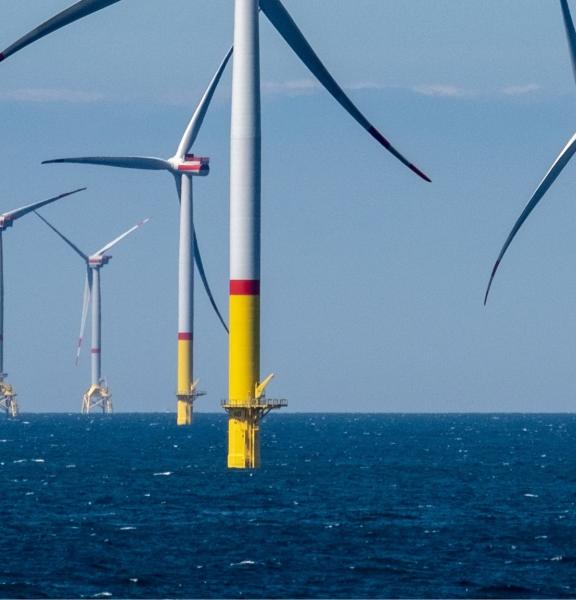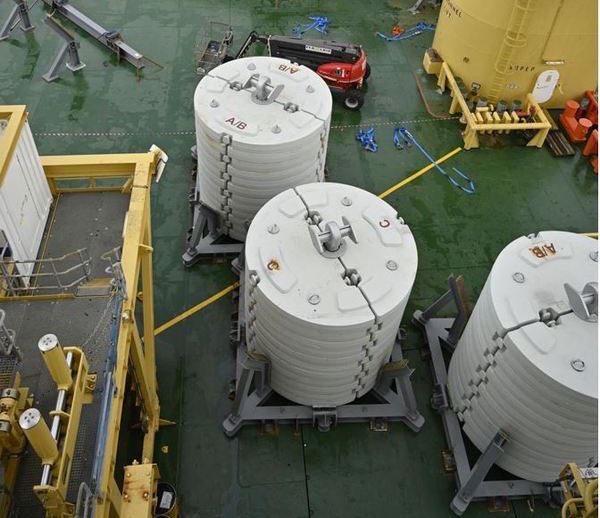
Offshore renewable energies, such as offshore wind, have experienced rapid growth over the last few decades.
As wind turbines, the floating foundations, and substructures continue to increase in size, weights but also needs adaptations to meet the expectation for reliability, costs efficiency and easier operation and maintenance activities. Industrialization will also be a key enabler to Gigawatt scale projects.
Mooring and Anchoring will also need adaptation to allow the deployment of hundreds of mooring lines over one or two years while also ensuring the proper stabilization of the floating wind turbines over their operational lifespan, which is typically over 20 to 30 years.
Gravity Anchors for Stabilization
Gravity anchors and ballasts have emerged as a reliable solution for ensuring the stabilization and anchoring of subsea foundations and structures. They are highly suitable for addressing the constraints induced by challenging seabed and meteocean conditions.
FMGC solutions, made of Cas Iron feature an high density coupled to a huge modularity, allowing to provide a significant weight in a reduced space, making them an ideal choice for stabilizing critical components and structures. Moreover, the system, able to feature hundreds to thousands of tons, is able to withstand multidirectional loads both in horizontal and vertical.
Companies specifications expand_more
FMGC
The history of the FMGC goes back to 1929 and if it continues today, it is because the company has never stopped developing to be attentive to its customers.
Applications expand_more
Dynamic Cable Anchoring
Dynamic cable systems became of critical importance since they are directly exporting the power generated by floating offshore wind turbines.
Considering the needs for an high service availability, their reliability and especially the fatigue solicitations, require specific attention. Buoyancy modules and tethering systems are commonly used to ensure the proper dynamic all along the water column. Anchoring systems play a vital role in compensating buoyancy or keeping tethers in position. Thanks to the high density and modularity of FMGC gravity anchors, significant cost savings and optimization can be achieved in terms of supply and installation. The system's modularity allows it to meet project requirements in weight per modules, geometry, and connection systems.
Floating Platform Anchoring
Floating Platform Anchoring Some site locations are known for their abundant power resources like wind and tides, but they often have challenging seabeds. When traditional anchoring systems fall short, gravity anchors can ensure the required holding capacity to withstand environmental loads. These anchors can also withstand multidirectional loads both in horizontal and vertical and are well-suited for anchor mutualization.
FMGC Gravity anchor solutions are fully modular to meet specific project requirements. They are also designed to consider the installation and deployment constraints, either in terms of available equipment, lifting capabilities or operational windows.
Thanks to the high density of the system, the seabed footprint is extremely limited, limiting the environmental impact and the area subject to hydrodynamic loads.
Also, the system is fully recoverable and recyclable at the end of life, allowing to finance a part of the decommissioning activities.
Gravity Base & Static Ballast
Many offshore structures, whether fixed or floating, require ballast. Tidal turbines, gravity-based foundations but also floating substructures needs a solution to bring hundreds to thousands of tons into a confined space. FMGC Gravity ballast, with their density and versatility in shapes and assemblies, significantly optimize the dimensioning of substructures and reduce associated costs.
Ballasting Modules are designed and certified according to project requirements and installation constraints to ensure reliable & cost effective solutions.
Design Engineering & Certification expand_more
Through its highly experienced teams and strong track records over the years, FMGC is used to extensive and challenging projects.
Whether FMGC resort to standard or bespoke approach, the main goals are to ensures optimization in construction, installation, and system integration.
This consideration starts from the basic design where the first approach are established considering every project specifications & details and is expressed all along the project.
The dimensioning and structural integrity is ensured through comprehensive assessment of the system, using numerical modeling and scale tests.
This high level of standards, from design to deployment allow the solutions to be fully approved and certified for the project design life.
We are also going along our partners and customers to define the most suitable approach and methodology to proceed to assembly, construction and offshore installation, establishing the methodology in accordance with the industry good practices, HSE standards & available equipment and infrastructures.
Track Record expand_more
Gravity anchors have been successfully applied in various projects, including :
- Windfloat Atlantic Dynamic Cable
- Gravity Anchors for LIDAR & Monitoring buoys
- Oceanquest (Hydroquest) - Gravity base ballast for the foundation
- Natick (Naval Group / Microsoft) - Gravity base ballast for the foundation
- P66 (Guinard) - Gravity base ballast for the foundation
- D10 (Sabella) - Gravity base ballast for the foundation


